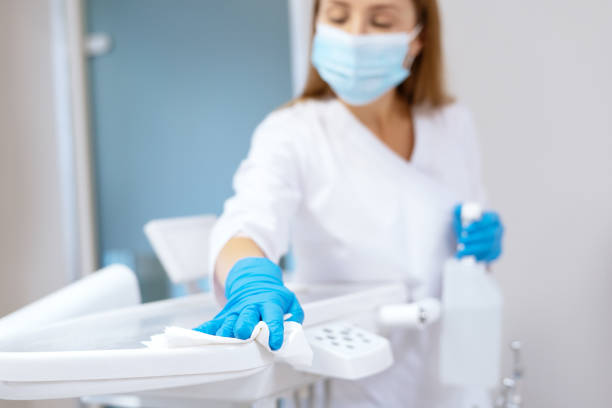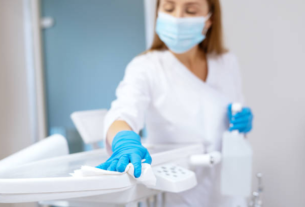Introduction
Maintaining a high standard of cleanliness in healthcare facilities is crucial for ensuring patient safety and effective infection control. Medical cleaning plays a vital role in protecting both patients and staff from harmful infections. With concerns like COVID-19 highlighting the importance of such practices, healthcare environments must adhere to strict cleaning protocols. Medical cleaning is not just about aesthetics, it’s essential for reducing the spread of infections and diseases in places like hospitals and clinics. You can delve deeper into these standards by referring to OSHA.
Understanding Hospital Cleaning Services
In healthcare settings, hospital cleaning services are tasked with more than just routine tidying. Their primary goal is to ensure a hygienic environment that adheres to stringent health regulations.
These services face unique challenges:
- High-Risk Areas: Hospitals have areas that require extra attention, such as operating rooms and intensive care units.
- Infection Control: Regular disinfecting and cleaning practices must be observed to minimize infection risks.
- Waste Management: Hazardous medical waste needs specialized handling to prevent contamination.
Cleaning staff members require specialized skills and training to handle these challenges efficiently. This includes knowledge of various cleaning techniques and the ability to use specific cleaning agents and equipment. The healthcare cleaning industry is evolving with ongoing research into effective practices. By maintaining clean and sanitized environments, medical centers can effectively safeguard patient health and meet healthcare standards.
Key Techniques of Healthcare Cleaning Services
Medical cleaning in healthcare facilities requires precision and specific techniques to ensure a safe environment for patients and staff. Here are some core techniques and methods used by healthcare cleaning services:
- Sterilization: This is a critical process that eliminates all forms of microbial life, including bacteria, viruses, fungi, and spores. Instruments and medical areas undergo rigorous sterilization to prevent the risk of infection.
- Sanitization: While sterilization is more intensive, sanitization reduces the microbial load to a safe level. This involves cleaning surfaces with chemical agents to minimize the spread of germs.
- Use of EPA-Approved Disinfectants: Choosing the right disinfectants is crucial. The EPA approves certain disinfectants as safe and effective for use in healthcare settings. These are used to ensure surfaces are genuinely clean and safe.
- Adhering to WHO Guidelines: It’s essential to follow well-established protocols like those provided by the World Health Organization. The WHO offers comprehensive guidelines on effective cleaning techniques that healthcare facilities can use to enhance their cleaning processes.
Choosing a Hospital Cleaning Company
Selecting the right hospital cleaning company is pivotal for maintaining hygiene standards in a healthcare setting. Here are some practical tips to consider:
- Certifications: Verify that the company is certified and follows all necessary healthcare regulations. Certification is a mark of quality and adherence to standards.
- Experience: Choose a company with extensive experience in the healthcare sector. They should understand the unique challenges and requirements of medical cleaning.
- Reputation and Testimonials: Look for reviews and testimonials from previous clients. Positive feedback often indicates reliable and effective service.
- Compliance with Regulations: Ensure that the company complies with all healthcare standards and guidelines. They must follow practices outlined by entities like the Joint Commission.
By considering these factors, healthcare facilities can choose a hospital cleaning company that will help maintain high standards of safety and cleanliness.
Innovations in Medical Center Cleaning
In the ever-evolving world of healthcare, staying updated with the latest cleaning technologies is key to maintaining high standards of hygiene and safety. Medical center cleaning is no exception, and several innovations are revolutionizing how these facilities stay clean and safe for both patients and staff.
New Technologies in Cleaning:
Here are some of the most impactful innovations in medical center cleaning today:
- UV Sterilization: This technology uses ultraviolet light to kill germs and bacteria efficiently. It can be especially useful in sterilizing rooms quickly without the need for chemical disinfectants.
- Robotic Cleaning: Robots designed for cleaning can navigate healthcare facilities to perform tasks like sweeping, mopping, and disinfecting surfaces. Robots can operate in high-traffic areas without disrupting regular operations.
- Electrostatic Sprayers: They apply disinfectants in a more efficient manner by using charged particles to ensure uniform coverage of surfaces.
- Antimicrobial Coatings: These are applied to surfaces to inhibit the growth of bacteria and viruses for extended periods.
For more on how technology is shaping the future of healthcare cleaning, view this helpful infographic discussing these innovations.
Impact of Innovations:
- Improved Infection Control: New technologies help in reducing the spread of infections and ensure a safer environment.
- Cost Efficiency: Automation and enhanced technologies reduce labor costs and improve efficiency.
- Enhanced Safety Measures: With advancements like no-touch controls, these innovations minimize potential contamination exposures for both staff and patients.
Modern medical center cleaning technologies are transforming standards of hygiene, offering practical and effective solutions for maintaining impeccable cleanliness in healthcare settings.
Ensuring Safety with Healthcare Cleaning Companies
Safety is at the forefront of healthcare cleaning services, not just for users of the facility but also for the cleaning staff. It’s crucial for healthcare cleaning companies to establish comprehensive safety protocols that adhere to industry standards.
Implementing Safety Protocols:
Healthcare cleaning companies ensure safety in the following ways:
- Training and Certification: Employees receive thorough training and may obtain certifications that enable them to understand and effectively apply cleaning protocols safely.
- Personal Protective Equipment (PPE): Workers are equipped with suitable PPE including gloves, masks, and gowns to protect against exposure to infectious agents.
- Regular Audits and Inspections: Routine checks help in identifying and addressing potential safety issues promptly.
Ensuring Patient and Staff Safety:
- Risk Assessments: Regular safety risk assessments help to identify any potential areas of concern.
- Use of Safe Cleaning Agents: Choosing non-toxic, EPA-approved cleaning agents ensures effective sanitation without harmful side effects.
- Emergency Protocols: Having clear plans for handling spills or exposure events ensures preparedness in any situation.
With these measures in place, healthcare cleaning companies are pivotal in creating a safe and healthy environment, minimizing risks for everyone involved in healthcare settings.
Benefits of Partnering with Professional Medical Cleaning Companies
Partnering with professional medical cleaning companies brings a variety of advantages to healthcare facilities, ensuring both safety and operational efficiency. Here are some key benefits:
- Enhanced Safety: Professional companies use industry-standard cleaning protocols that reduce the risk of infections, creating a safer environment for both patients and staff. They are adept at identifying and mitigating health risks associated with healthcare environments.
- Improved Efficiency: With specialized training, these professionals are able to clean more thoroughly and efficiently than in-house staff, often freeing up internal resources.
- Expertise and Experience: Medical cleaning companies come equipped with extensive knowledge of healthcare-specific cleaning requirements. This includes understanding complex healthcare regulations and how to best meet them, which is crucial to maintaining compliance.
- Access to Advanced Technologies: Many companies invest in the latest cleaning technologies, such as UV sterilization and microfiber cleaning. These innovations improve the thoroughness of cleaning and help extend the life of healthcare facility infrastructure.
- Consistent Quality: Hiring professionals ensures a high standard of cleanliness is consistently maintained, which is critical for accreditation and patient trust.
Ensuring Compliance with Hospital Cleaning Regulations
Compliance with hospital cleaning regulations is crucial for healthcare facilities to maintain high safety and quality standards. Here’s how to ensure it:
- Understand Key Regulations: Familiarize your facility with standards set by regulatory bodies such as the Joint Commission and the Centers for Medicare & Medicaid Services (CMS).
- Regular Training and Audits: Continuous education and regular compliance audits are essential. They help ensure that staff remains up-to-date with current guidelines and that all protocols are being followed correctly.
- Documentation and Record-Keeping: Maintain detailed records of cleaning activities, processes, and any incidents. This documentation is vital for both internal reviews and external inspections.
- Leverage Professional Help: Utilize resources or consult with professionals to guide your facility through intricate compliance landscapes.
By adopting these practices, healthcare facilities can better ensure they meet essential regulations and maintain a safe, clean environment for everyone involved.




